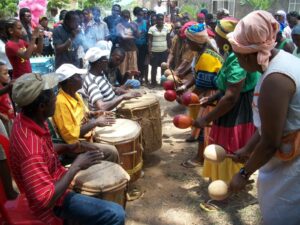Lumagien Yurumein daga Lamida Meriga
The living heritage of Garifuna people from the Island of Saint Vincent
to Central America and the United States
Andoni Castillo Perez
Garifuna writer and historian
UNESCO-Research Commissioner
Member of Black Central American Organization

“The image describes the spiritual ceremony of the indigenous Garifunas, through their drums and maracas, instruments of communication with nature and the spirits of their ancestors, transporting them towards the encounter with their own plenitude, in addition the drum symbolizes the voice of their resistance and they still maintain their worldview and fight tirelessly to maintain it”.
Photo by: Humberto Castillo
The Garifunas, an indigenous people originating from (Saint Vincent of the Lesser Antilles). They had contact with the first Europeans in 1620 and remembered their history in the presence of the European Jesuit missionaries, and told them their ancient oral traditions. The Garifuna indigenous people live along the Atlantic coast, distributed in more than 70 communities dispersed in the Central American Caribbean, from the community of Hopkins in Belize, through Livingston in Guatemala, crossing the entire coastal strip of Honduras until reaching Orinoco in Nicaragua.
In May 2001, UNESCO proclaimed “The music and dance of the Garinagu indigenous people as a masterpiece of the intangible heritage of humanity” and in 2008 it was inscribed on the Representative List of the Intangible Cultural Heritage of Humanity. The UNESCO declaration is considered by the Garifuna indigenous people as an important instrument of recognition. However, after 20 years of the proclamation they face significant challenges such as the erosion of their language, loss of territories, discrimination, and exploitation of natural resources, climate change and lack of full participation in decision-making processes policies that affect their cultures and ways of life in the region.
The United Nations General Assembly proclaimed the period from 2022 to 2032 as the International Decade of the World’s Indigenous Languages (DILI 2022-2032), with the aim of guaranteeing the right of indigenous peoples to preserve, revitalize and promote their languages, and integrate aspects of linguistic diversity and multilingualism in sustainable development efforts.
In this context, the greatest challenge the Garifunas indigenous people facing is the danger of losing their mother tongue, which belongs to the Amerindian (Arawak) linguistic group of the Antillean Caribbean and elements of (Mande) of West Africa and contains gender elements and is spoken by the indigenous Garifuna people in Honduras, Belize, Guatemala, Nicaragua and the United States of America.
That is why the Convention for the Safeguarding of Intangible Cultural Heritage, signed in 2003, states that its purpose is “the safeguarding of intangible cultural heritage, respect and awareness at the local, national and international level”, and to achieve this To this end, multiple joint efforts are required with the participation of different actors, to strengthen the multiple initiatives that communities, but it also reaffirms the urgency of promoting language conservation projects, creating safeguarding policies and protection strategies, allocation of resources to mitigate and ensure the adequate preservation of the living heritage of the Garifuna people.
Download PDF: Garifuna Living Heritage – Andoni Castillo Perez.pdf

